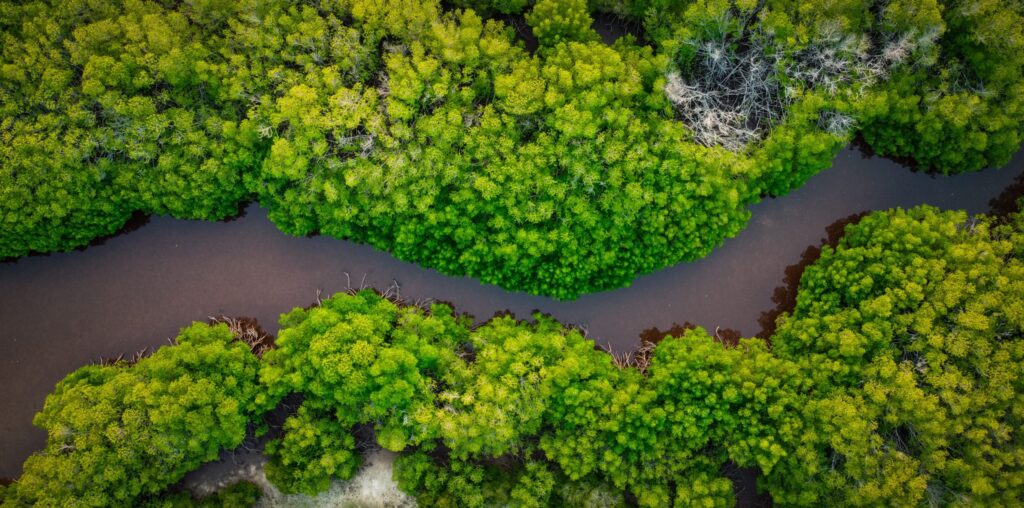There are many reasons why the Amazon rainforest is one of the wonders of the natural world. Here are the most succinct ones:
Animal species diversity

The cute squirrel monkeys feel even more at home in the Amazon rainforest than on Pippi Longstocking’s shoulder.
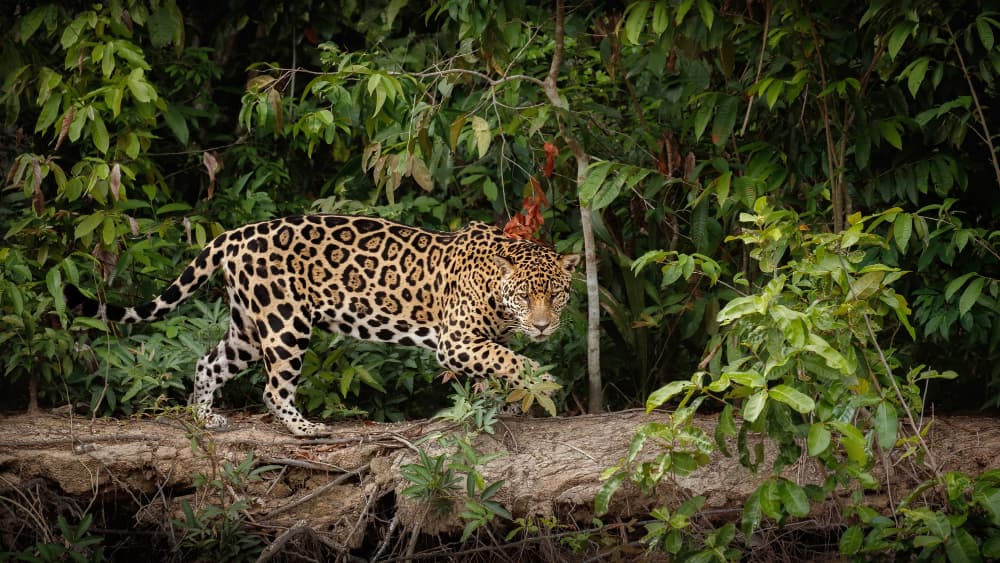
For the jaguar, the Amazon rainforest is the last quiet place in Central and South America.
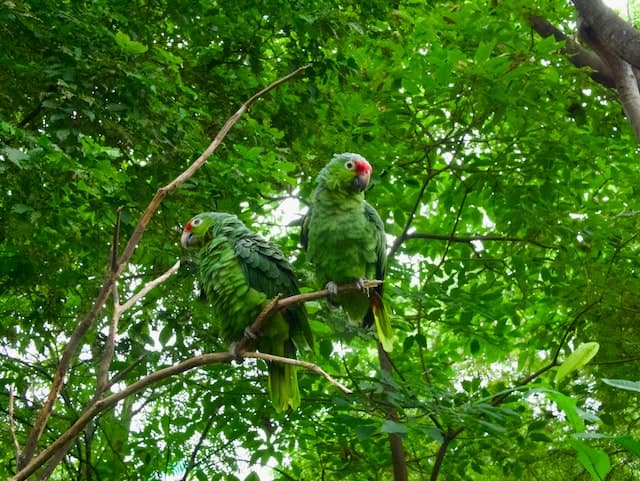
Like these two beauties, adult Amazon parrots generally travel in pairs. Therefore, one suspects that they form long-term relationships.
Green Lung
Plant diversity
More than 40,000 different plant species live in the Amazon rainforest. Among them are many that are promising for the development of medicines and research into diseases of civilisation. So the next active ingredient against diabetes could be growing in the rainforest!
Rain provider
After this small insight into the treasure trove of the Amazon rainforest, however, now the sad reality:
Every year 13,000 km2 rainforest are cleared!
In the time you have been reading about the beauty of this forest, it has become smaller by about 50 m2.
Here is an illustration of the current extent: on 22 August 2022, satellites of the Brazilian agency INPE recorded 3,358 separate fires in the Amazon rainforest. This is an increase of 22% compared to the previous year! At this point it is interesting to mention that fires in the Amazon rainforest do not occur naturally at all. Due to the high humidity here, it always needs human intervention. Such fires serve as a cover for illegal logging.
Some last important figures that make us aware of the problem. According to INPE, about 17% of the Amazon rainforest has been cut down in the last 40 years. Compared to the amount of forest that is still standing, this figure does not seem too frightening. It becomes dangerous when the so-called tipping point is reached. From then on, the rainforest loses its ability to absorb CO2 and even releases some! This tipping point is reached as soon as an estimated 20% to 25% of the Amazon rainforest has been cleared. Therefore, the current record deforestation is seen as the beginning of the end.
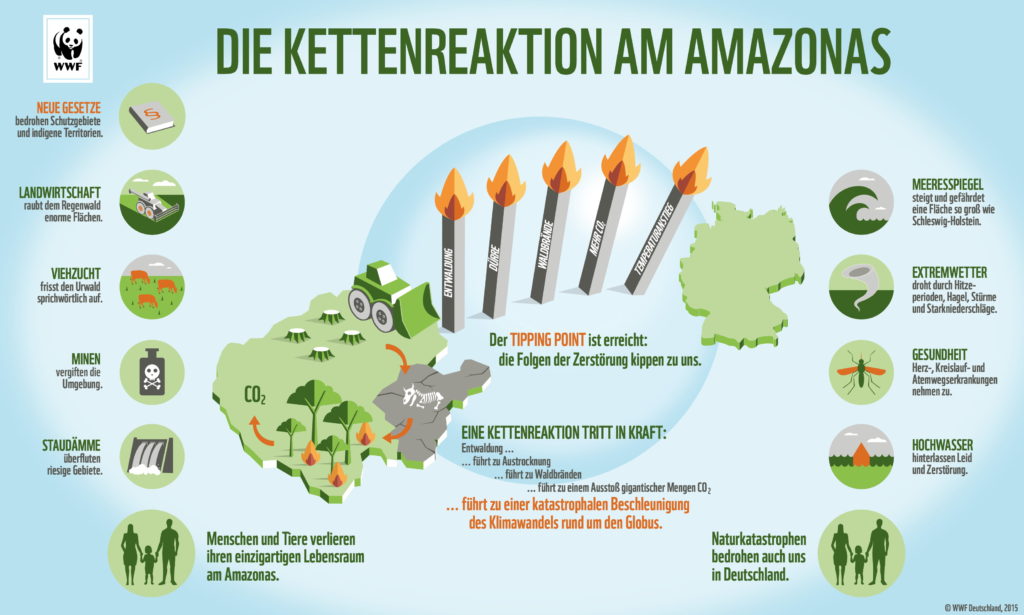
We are heading for the tipping point
That sounds scary – but what exactly did it lead to?
As discussed, the rainwater produced by the rainforest prevents droughts. Without the forest, these would become more frequent and lead to crop failures, drinking water and food shortages
The unique biodiversity would also be and is already being destroyed: it is estimated that deforestation of the rainforest is wiping out up to 1,000 different species every day.
But giving up our green lungs would have even more far-reaching consequences. It is estimated that the rainforest has sequestered as much carbon from the atmosphere as will be released as CO2 in the entire world in 10 to 15 years. Burning down the rainforest would release these billions of tonnes of stored CO2. In addition, natural fires would occur if there is no longer enough rain produced here. This combination would acutely fuel climate change.
In addition, of course, the incomparable capacity of the Amazon rainforest to draw CO2 from the atmosphere would be lost. We know the consequences (global temperature rise, rising sea levels, melting glaciers, drinking water and food shortages, climate refugees).
Phew, that’s pretty infuriating.
But it is too easy to blame the local governments, states and farmers. The economically weak countries here are overshadowed by our large industrialised nations. Our politicians, as well as we as consumers, are jointly responsible and, above all, capable of removing the financial incentives for the deforestation of the Amazon.
So the important question follows:
What can we do?
But don’t fall for the big coffee brands’ own “eco” labels, whose guidelines they set themselves.
-
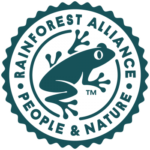
The Fairtrade Seal of the Rainforest Alliance - If you use barbecue charcoal, make sure that no tropical woods sneak in. The barbecue charcoal will then bear a corresponding label. Unfortunately, the FSC seal is only partially reliable.
- The same goes for leather, wood, paper and cellulose. If you hardly use paper because you take notes on your mobile phone, consider using washable rags instead of kitchen paper and recycled toilet paper. And the next time it’s time to replace wooden furniture, go for local woods or even save money by looking for second-hand furniture.
- Follow indigenous influencers, such as @alice_pataxo, @jessicakumaruara or @cunhaporangaoficial. In this way, you will gain insights into their lives with the rainforest and learn how nature can be used in a non-destructive way.
- Become active!
As you can see, these tips are mainly related to your individual behaviour. If you doubt what your actions as an individual can achieve, you can consider the following points:
Firstly, demand determines supply. If less conventional and more recycled toilet paper is bought, this will be reflected in the producers.
Secondly, you are also a direct role model for others with your (consumer) behaviour. If you put a vegetarian lasagne on the table at the next dinner, five other people won’t eat meat that night (or three, depending on how big your lasagne is)! Two prime examples of the snowball effect!
We can summarise that the animal and plant diversity of the rainforest and its abilities to store carbon, produce oxygen and generate rainwater make it a unique ecosystem. Nevertheless, it is cleared every day to make way for cattle pastures, soy fields and dams, or to extract raw materials. Soon, this will trigger a chain reaction that will turn the rainforest from a CO2 sink into a CO2 source and acutely accelerate climate change. To prevent this, we can make a considerable contribution to protecting the Amazon rainforest through small changes in behaviour.
Lastly, let us know what you think about the big topic of the Amazon rainforest! Or if you have further tips and experiences, please contact us via the contact form.
